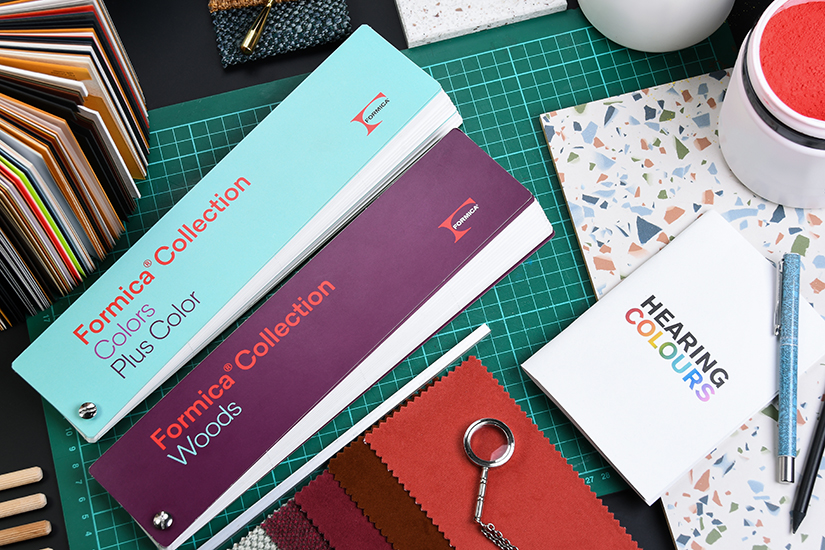The Science of Light Reflectance: A Guide to LRV in Interior Design
The Science of Light Reflectance: A Guide to LRV in Interior Design
There’s more than just aesthetics to consider for an interior design scheme. When selecting materials and colours for a design project, architects and designers consider one factor that significantly impacts a space, is Light Reflectance Value (LRV).

LRV is a number which indicates the proportion of light reflected by a colour, when measured under standard daylight conditions. Put simply, it tells you whether a colour looks light or dark. The guidance uses a scale of 0-100, where 0 equals black and therefore total light absorption, whereas white equals 100 and therefore total light reflection.
The main purpose of this value to interior designers and architects is to indicate measured colour contrast between two surfaces, which need to be readily distinguishable within an environment.
Regulatory LRV in European design
Some EU countries have guidelines around for LRV, especially in relation to accessibility, workplace safety, and energy efficiency. While there is no single EU-wide LRV regulation, several European standards and national building codes include LRV-related guidelines.
Many countries align with the European Accessibility Act (EAA) and EN 17210:2021, which set out accessibility standards for buildings and public spaces. LRV contrast is often used to assist the choice of surface colour to help visually impaired individuals navigate spaces safely and is commonly used as a tool in correctly displaying wayfinding signage such as emergency exit signs, to ensure visibility in low-light conditions.
For example, in the UK, BS 8300-2:2018 – ‘Design of an accessible and inclusive built environment. Buildings – Code of practice’ provides guidance of an acceptable level of minimum LRV contrast of 30 points between adjacent surfaces (eg. floors vs. walls or walls vs. doors) to aid visibility and accessibility. Under static conditions, a difference of 30 units between two colours is considered adequate.
Other provision may also be supported by considering LRVs as a design tool, such as the Equality Act 2010 (UK), particularly in relation to improving accessibility for people with visual impairments.
While the Act does not explicitly mention LRV, the guidance supports designers to make informed choices, promoting good design practice. This helps public spaces and workplaces to be accessible to disabled individuals, including those with visual impairments.
LRV as a Design Tool
With that in mind, LRVs are a vital tool for designers to use in several aspects of European interior design:
1. Natural Light Optimisation
Many European countries, especially in the north, experience long, dark winters. Designers may use LRV to choose colours that reflect more natural light and create brighter, more inviting interiors.
In southern Europe, where sunlight is intense, dark colours are sometimes used to reduce glare and create a cosier feel.
2. Energy Efficiency & Sustainability
Using LRV to choose colours that help maximise natural daylight, reduces the need for artificial lighting and lowering energy costs - a major consideration in eco-conscious European design.
Some building regulations and sustainability certifications consider LRV when selecting materials for efficiency.
3. Aging Population & Accessibility Standards
Many European countries emphasise accessibility in public and private spaces. Contrasting surfaces, achieved through differences in Light Reflectance Value (LRV), are an effective tool for enhancing visibility and aiding navigation for the elderly and visually impaired.
4. Aesthetic Considerations
Scandinavian design often features light, tones to enhance spaciousness, while Mediterranean interiors may incorporate more earth tones for warmth. LRV reveals how these colours interact with the available light in a space, helping achieve the desired look.
5. Commercial & Workplace Design
In office and retail spaces, where lighting affects mood and productivity, LRV can help select colours to create a comfortable environment.
How Formica® Laminate helps Designers with LRV
At Formica Group, we note LRVs for all laminates in the Formica® Collection to support designers in making informed design decisions as part of a wider interior design. With immediate access to LRVs, designers can quickly make colour and material decisions that meet accessibility standards and ensure spaces are both aesthetically pleasing and functional.
It is worth noting, that for non-solid coloured laminates, where there are multiple colours across a design, such as woodgrains or patterns, the stated LRV is an average value taken from multiple measurements across the decor and must be used with caution. Individual colours in a pattern, stone or woodgrain can differ more than 30 LRV units within the design itself.
LRV’s are also affected by the texture of the laminate. Smooth, glossy surfaces reflect more light, and may appear lighter, rough, matt, or textured surfaces absorb more light, making colours look darker.
While LRV is not explicitly regulated, it is widely used as a design principle across Europe. By understanding how light affects surfaces and our perception of colour, designers can create spaces that are not only stunning, but also compliant, more inclusive and energy-efficient.
Explore the full Formica Collection plus Formica Doors Collection and Formica Washrooms for your next project
Please note: LRV’s quoted in the Formica Collection or Formica Doors Collection are based on a matt sample. LRVs stated in product marketing material may or may not be exact and are provided for guidance only. We recommend ordering a sample of the décor in the desired surface finish to accurate assess its LRV and suitability.



